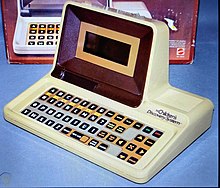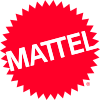Children's Discovery System
 | |
| Manufacturer | Mattel |
|---|---|
| Generation | Second generation |
| Release date | September 1981 |
| Discontinued | 1984 |
| Media | Learning Module ROM cartridges |
| Memory | 2k RAM |
| Display | LCD 16x48 |
| Input | Membrane keyboard |
The Mattel Children's Discovery System is an early electronic educational toy product released by Mattel in 1981. The Children's Discovery System was targeted toward children aged 6 to 11[1] and mimicked the look of a contemporary consumer-grade computer.
History[]
The system was developed by Mattel with the help of UCLA professor Dr. Gordon L. Berry, who was chief educational consultant on the project.[2]
It was announced at the American International Toy Fair on February 1981,[3] and released later that year.
One review noted how small the screen resolution was, which limited it severely, and how slow the system was to startup. The included game-modes on the console were also criticized, the type-mode didn't provide feedback on its word games, music-mode was described as pointless due to how basic it was and how the music is represented by letter graphics instead of notes, but the art-mode was praised for being a good introduction to computer graphics, although the process of drawing pixel-by-pixel was described as tedious.[4]
In the Fall of 1984, Mattel liquidated the remaining 8000 units and learning modules to DAK Industries, where they sold through mail order a bundle that included the console with 14 learning modules for $79, nearly the entire library of games.[5]
Specifications[]
The Children's Discovery System used a 16-by-48 matrix LCD screen[6] and was powered by six size AA alkaline batteries.[7] The screen was much wider than it was tall, therefore only a grid of 8-by-2 text was possible, allowing for a maximum of 16 characters on-screen at any given moment.
The unit came preprogrammed with three modes: Art mode, Music mode and Type mode. The Discovery System came with a specially laid-out membrane keyboard to better accommodate the built-in modes and also made use of keyboard overlays for use with expansion modules. Also included with the unit was a large activity book with over 100 suggested learning activities specially-tailored for the Discovery System.[8]
Expansion module cartridges[]
Besides the 3 included modes on the console, one could buy other game cartridges with different games. Each cartridge is numbered from 1 to 21, and all have the Discoveries in ---- Learning Fun Module name, where the ---- is the name of the actual game, and what is written on the cartridge. Each Module has several different modes for different games, and an age range depending on the content.
Although the system was advertised alongside 21 different modules singe the beginning, all 21 weren't ready at launch, most being developed and released at latter dates. Some of the Modules are unknown if they were ever developed/released at all.
Each box is a different color, and collecting them together creates a color gradient with the spines. Photos of different children are used in the front of each box.
- Background shading indicates the color of the box and number on the spine of each game.
| # | Code | Age Range | Fun Module | Game Modes Listed in the Box |
|---|---|---|---|---|
| 1 | 1606 | 6-11 | Math I |
|
| 2 | 3349 | 6-11 | Arcade Action I |
|
| 3 | 1607 | 6-8 | Words I |
|
| 4 | 1609 | 6-11 | Art |
|
| 5 | 1608 | 6-11 | Music |
|
| 6 | 3346 | 9-11 | Words II |
|
| 7 | 3731 | 6-11 | Arcade Action II |
|
| 8 | 3733 | 6-11 | Memory And Logic |
|
| 9 | 3732 | 6-11 | Geography I |
|
| 10 | 3734 | 6-11 | Foods |
|
| 11 | 5165 | 6-8 | Fractions I |
|
| 12 | 3347 | 9-11 | Fractions II | |
| 13 | 3350 | 9-11 | Science I |
|
| 14 | 3835 | 6-11 | Presidents |
|
| 15 | ||||
| 16 | 5329 | Computer Programming | ||
| 17 | ||||
| 18 | 5328 | 9-13 | Spelling Fun |
|
| 19 | ||||
| 20 | ||||
| 21 |
Other games/ unknown number;
- Math Quiz/Calculator
- Nutrition
- (4456) US Cities
- (3347) History
- (3348) Sports
References[]
- ^ "Handheld Game Museum - Children's Discovery System (Mattel 1981 catalog)".
- ^ https://archive.org/details/PersonalComputing198202/page/n89?q=Children%27s+Discovery+system
- ^ https://archive.org/details/creativecomputing-1981-09/page/n279?q=Children%27s+Discovery+system
- ^ https://archive.org/details/creativecomputing-1981-12/page/n63?q=Children%27s+Discovery+system
- ^ https://archive.org/details/1984-Fall-DAK-Catalog/page/n7
- ^ "The Great Game Database - Mattel Children's Discovery System". Archived from the original on 2011-07-11.
- ^ "Computer History Museum - The Children's Discovery System computerized learning system". Archived from the original on 2012-10-01. Retrieved 2008-08-30.
- ^ "Handheld Game Museum - Children's Discovery System (Mattel 1981 catalog)".
External links[]
- Educational toys
- Mattel
- Products introduced in 1981
- Second-generation video game consoles
- Handheld game consoles
- Video games developed in the United States
